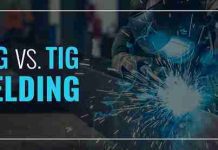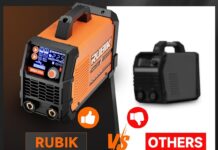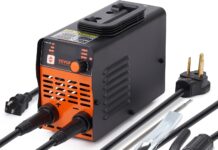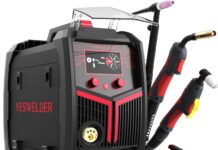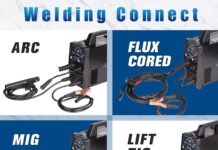In order to successfully undertake any welding project, there are a number of essential tools and accessories that one must have at their disposal. From protective gear such as welding helmets and gloves, to the actual tools like welding machines and electrodes, each component plays a crucial role in ensuring a safe and efficient welding process. Whether you’re a seasoned welder or just starting out, understanding the importance of these tools and accessories is key to achieving professional results and maintaining a high level of safety in your work. So, let’s take a closer look at the essential tools and accessories needed for welding.
Welding Machines
MIG Welder
One of the most commonly used welding machines is the MIG welder, which stands for Metal Inert Gas. This machine uses a wire electrode to create an electric arc that melts and fuses the metal together. MIG welding is known for its ease of use and versatility, making it suitable for both beginner and experienced welders.
TIG Welder
Another popular option is the TIG welder, which stands for Tungsten Inert Gas. Unlike MIG welding, TIG welding uses a tungsten electrode to produce the arc, and a separate filler rod is added to the weld pool. TIG welding is highly precise and offers excellent control, making it ideal for welding thin materials and achieving clean and precise welds.
Stick Welder
Stick welding, also known as Shielded Metal Arc Welding (SMAW), is a traditional and reliable welding process. It uses a consumable electrode coated in flux to create a protective shield around the weld pool. Stick welding is versatile and can be used on a wide variety of metals, making it a popular choice for outdoor and construction applications.
Flux-Cored Welder
A flux-cored welder is similar to a MIG welder, but instead of using a solid wire electrode, it uses a hollow wire filled with flux. The flux provides a shielding gas and helps remove impurities from the weld, resulting in a cleaner and stronger bond. Flux-cored welding is ideal for welding thick materials and is commonly used in heavy-duty applications such as shipbuilding and construction.
Welding Safety Equipment
Welding Helmet
A welding helmet is a crucial piece of safety equipment that protects the welder’s face and eyes from harmful UV rays, sparks, and debris. The helmet is equipped with a darkened lens, typically an auto-darkening lens that automatically adjusts the shade based on the brightness of the arc, ensuring clear visibility while welding.
Welding Gloves
Welding gloves are designed to protect the hands from heat, sparks, and flames. They are made from flame-resistant materials and provide excellent dexterity and grip for handling hot materials and operating welding tools.
Welding Jacket
A welding jacket is worn to protect the upper body from sparks, slag, and radiant heat. It is made from fire-resistant materials and typically features a stand-up collar and long sleeves to provide full coverage and protection.
Welding Apron
A welding apron offers additional protection for the lower body, particularly the legs and lower torso, from sparks, heat, and spatter. Like welding jackets, welding aprons are made from flame-resistant materials, such as leather or heavy-duty cotton, to protect against potential hazards.
Welding Respirator
Welding produces hazardous fumes and gases, and a welding respirator is essential for protecting the welder’s respiratory system. Respirators are designed to filter out harmful particles, such as metal fumes and gases, ensuring clean and safe air for the welder to breathe.
Welding Consumables
Welding Electrodes
Welding electrodes, made of metal or alloy, are used to conduct the electric current during the welding process. They come in various types and sizes, depending on the welding application and the metal being welded. The choice of welding electrode is crucial to achieve the desired weld quality and strength.
Welding Wire
Welding wire is used in MIG and flux-cored welding processes. It serves as the filler material that is heated and melted to join the workpieces together. Welding wires are available in different materials and thicknesses to suit various welding applications and metal types.
Welding Flux
Welding flux is used in flux-cored welding processes to shield the weld pool from atmospheric contamination. It is a chemical compound that, when heated, produces a protective gas to prevent oxidation and ensure a clean and strong weld. Welding flux also helps remove impurities and slag from the weld.
Welding Tools
Welding Clamps
Welding clamps are essential for holding workpieces securely in place during the welding process. They come in various designs, such as C-clamps, locking pliers, and magnetic clamps, providing flexibility and adaptability for different welding projects.
Welding Pliers
Welding pliers are multipurpose tools that aid in various welding tasks, such as removing hot slag, cleaning weld spatter, and holding small objects. They usually feature insulated grips and built-in cutters for convenience and safety.
Chipping Hammer
A chipping hammer is used to remove slag and debris from the weld surface after welding. Its pointed end allows for precise chipping and cleaning, ensuring a smooth and clean weld appearance.
Wire Brush
A wire brush is an essential tool for cleaning welds and removing rust, scale, and other impurities from metal surfaces. It is typically used in conjunction with a chipping hammer to achieve a clean and well-prepared surface for welding.
Welding Magnets
Welding magnets, also known as magnetic welding holders, are handy tools for securing and positioning metal workpieces during welding. They provide a strong magnetic grip, allowing for precise alignment and fixation, particularly when welding in challenging positions.
Cutting Tools
Cutting Torch
A cutting torch is a tool used for cutting through metal by applying heat and oxygen to create a high-temperature flame. It is commonly used in metal fabrication and demolition works to cut through thick materials quickly and efficiently.
Plasma Cutter
A plasma cutter is a powerful tool that uses a high-velocity jet of ionized gas, known as plasma, to cut through metal. It provides a clean and precise cutting edge and is widely used in various industries, including automotive, aerospace, and construction.
Oxy-Fuel Kit
An oxy-fuel kit is a versatile cutting tool that combines oxygen and a fuel gas, typically acetylene, to create a high-temperature flame for cutting and heating applications. It is widely used for metal cutting, brazing, and heating in various manufacturing and repair industries.
Personal Protective Equipment (PPE)
Safety Glasses
Safety glasses are a vital piece of personal protective equipment for welders, shielding the eyes from sparks, debris, and harmful UV rays. They often feature impact-resistant lenses and side shields for maximum protection.
Ear Plugs
Ear plugs are necessary to protect the welder’s ears from excessive noise produced during welding processes. Prolonged exposure to loud noises can lead to hearing loss, so wearing ear plugs is essential in maintaining auditory health.
Safety Boots
Safety boots, also known as steel-toe boots, are designed to protect the welder’s feet from heavy objects, falling debris, and electrical hazards. They typically have reinforced toes and soles to provide maximum protection and prevent injuries.
Fire-Resistant Clothing
Fire-resistant clothing, such as flame-resistant coveralls or pants and shirts, is crucial for protecting the welder’s body from sparks, flames, and radiant heat. These clothing items are made from materials that self-extinguish when exposed to flames, reducing the risk of severe burns.
Welding Workstation
Welding Table
A welding table is a sturdy and heat-resistant surface used as a workspace for welding projects. It provides a level and stable platform for positioning workpieces, welding tools, and accessories during the welding process.
Clamps and Vises
Clamps and vises are essential for securing workpieces to the welding table or workstation. They provide stability and prevent movement during welding, ensuring precise and accurate welds.
Grinder/Grinding Wheel
A grinder, equipped with a grinding wheel, is necessary for preparing metal surfaces before welding. It is used to remove rust, scale, paint, and other contaminants, creating clean and weld-ready surfaces.
Angle Grinder
An angle grinder is a versatile tool used for various grinding, cutting, and polishing tasks in welding and metalworking. It features a rotating abrasive disc or wheel and is ideal for tasks such as shaping metal, cutting through metal bars, or removing excess weld material.
Welding Accessories
Welding Wire Brushes
Welding wire brushes are used for cleaning welds and removing debris, rust, and scale from metal surfaces. They come in various sizes and bristle materials, ensuring efficient and thorough cleaning for different welding applications.
Magnetic Welding Holders
Magnetic welding holders, also known as welding magnets, provide an extra pair of hands for holding metal workpieces during welding. They offer strong magnetic stability and enable precise positioning and fixation, allowing for accurate and hassle-free welding.
Welding Curtains
Welding curtains, made from fire-resistant materials, are used to create a protective barrier between the welding area and other workspaces. They shield nearby objects and personnel from sparks, UV radiation, and other welding hazards, ensuring a safe and contained work environment.
Anti-Spatter Spray
Anti-spatter spray is a welding accessory that helps prevent weld spatter from adhering to the workpiece and welding equipment. It is applied to surfaces before welding to minimize spatter, making post-weld cleaning and maintenance easier.
Welding Cables and Connectors
Welding Cables
Welding cables are heavy-duty cables used to connect the welding machine to the electrode holder and ground clamp. These cables are designed to carry high currents safely and efficiently, ensuring a reliable connection during the welding process.
Ground Clamp
The ground clamp is an essential component of the welding circuit that connects the workpiece to the welding machine’s ground terminal. It provides a secure electrical connection and ensures proper grounding, enhancing the efficiency and safety of the welding operation.
Electrode Holder
The electrode holder, also known as the stinger or electrode clamp, holds the welding electrode and allows the current to pass through. It is an essential tool that provides a secure grip on the electrode and enables precise control and manipulation during welding.
Welding Gas and Accessories
Shielding Gas
Shielding gas is used in certain welding processes, such as MIG and TIG welding, to protect the weld pool from atmospheric contamination. Common shielding gases include argon, carbon dioxide, and mixtures of various gases, depending on the specific welding application.
Gas Regulator
A gas regulator is a device that controls the flow and pressure of the shielding gas from the gas cylinder to the welding torch or gun. It ensures a steady and consistent flow of gas, vital for maintaining proper shielding and achieving high-quality welds.
Gas Cylinders
Gas cylinders are containers used to store and transport various welding gases, such as shielding gases and oxygen for cutting applications. These cylinders are designed to withstand high pressures and are available in different sizes to suit different welding needs.
With the right tools and accessories in hand, welders can tackle various welding projects with confidence and efficiency. Whether it’s choosing the appropriate welding machine, ensuring personal safety with protective equipment, or having the necessary cutting tools and accessories, a well-equipped welding setup enhances productivity and promotes a safe working environment. Always remember to follow proper safety protocols and guidelines when working with welding equipment to ensure the best results and protect yourself and others from potential hazards.



